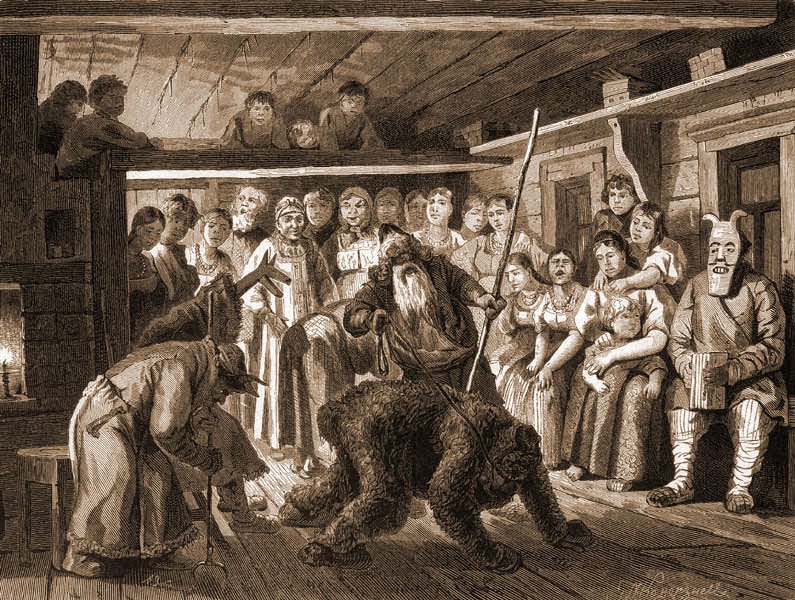Did Slavic people have a Halloween?
Answer to the most popular question I get asked during this season
VELES NIGHT
First, let’s put things straight. No, Velesova noch’ (Veles Night, Night of Veles) is not an ancient Slavic tradition. It’s a relatively new addition to the Slavic neopagan calendar, celebrated on February 11—or, for some, October 31, in a strategic alignment with Halloween. Presented as an age-old ritual honoring Veles, the god of cattle, wealth, poetry, and the underworld, Velesova noch’ has gained traction among enthusiasts who want to reconnect with Slavic roots. But despite its modern-day popularity and carefully crafted mystique, there’s simply no historical evidence that pre-Christian Slavs ever observed Velesova noch’. Instead, the holiday emerged from a wave of Slavic neopagan revival, where enthusiasts aimed to reconstruct lost traditions, creating new observances along the way. For some, it’s even become a “response” to Western holidays, an “authentic” alternative with a supposedly deeper, ancient resonance.
In its contemporary form, Velesova noch’ is often portrayed as a time when the veil between the living and the dead grows thin, not unlike the Celtic Samhain. Practitioners use the night to honor ancestors, calling on Veles for his protection over wealth and livestock, and for guidance in the coming year. Rituals typically involve offerings of bread, milk, honey, and other symbols of prosperity, laid at symbolic gates or home altars, inviting Veles into the realm of the living. Participants might also use this night for fortune-telling or divination, adding a mystical layer that mirrors the practices surrounding Samhain and Halloween.
HALLOWEEN
Now, let’s talk about Halloween, or as some would say, the “otherworldly festival” par excellence of the West. Historically, Halloween’s roots trace back to the Celtic Samhain, a night where, according to ancient belief, the boundary between the living and the dead dissolved. Celebrated on October 31, Samhain marked a transition in the natural world—the death of one cycle and the birth of another. During this night, the souls of deceased ancestors were believed to visit the world of the living, and people left offerings to appease them. Fast-forward to the 20th century, and globalization brought Halloween to every corner of the world, including the post-Soviet space, where it is celebrated as a holiday of costumes, trick-or-treating, and spooky décor. Despite losing much of its ancient character, Halloween holds a powerful appeal, perhaps precisely because it taps into the archetypal themes of death and renewal.
SVYATKI AND KOLYADA

The Eastern European Slavic analog of the meaning of Celtic Samhain is Svyatki, the celebration that is structured around three major church holidays in the folk calendar—Christmas (January 7), Old New Year (January 14), and Epiphany (January 19), covering a span of two weeks. According to Uliana Nikolaevna Solomennaya (born 1931) from the village of Neglyubka in Vetka District, Gomel Region, Belarus: "Kolyada begins with Christmas. Girls wait for Kolyada like waiting for God. For two weeks, in the evenings, no sewing, no spinning, only celebration. And by January 19—Epiphany—it’s two weeks of Kolyada. With Epiphany’s blessing of the water, Kolyada ends. Then comes the Meatfare (wedding season), and people marry off."
Traditional culture bearers in eastern Slavic regions call this two-week period "Kolyada." In certain villages, both names—Svyatki and Kolyada—are used. Like other calendar cycles, the Svyatki period has a marked beginning and end, with a distinct midpoint dividing it into two equal parts. These parts have acquired colloquial names, "holy" (святые) and "scary" (страшные) nights. The holiday dates each convey specific meanings: while the New Year celebrations are secular, the observances for Christmas and Epiphany are dominated by Christianity.
Work restrictions lasting two weeks are associated with the Svyatki period. In this time, the souls of deceased ancestors were thought to reside in the "this world," and any work might harm beings from both realms. Failure to observe these prohibitions could result in negative consequences, disrupting the balance between nature and human life.
This period is marked by visits from "parents" or "kinsfolk" (souls of deceased ancestors) to their relatives' homes. Special ritual food—kutya—is prepared in each family. This dish is made three times during Svyatki, for each of the holidays. Aksinya Lavrentyevna Feskova (born 1922) from the village of Stolbun, Vetka District, Gomel Region, Belarus, described the custom of inviting Frost to the feast, symbolizing the ancestors' spirits: "At the last kutya [the eve of Epiphany], when we boiled gushtya (thick soup), one of us would go outside and call out to Moroz. ‘Moroz, Moroz, come to eat gushtya! If you don’t come, we’ll beat you with an iron whip!’ Three times they knock at the corner, and back inside they go. The master sends either his son or goes himself.” O.A. Pashina explains: “These requests rest on beliefs in the omnipotence of the deceased, who, supposedly, manage the weather, bring harvests, droughts, fortune, and misfortune”.
What’s more, in Svyatki rituals, the offerings and exchanges between the living and ancestral spirits weren’t mere festivities but vital acts of kinship. Each interaction carried weight, signaling respect and continuity with the past. With Velesova noch’ taking shape as a “counterweight” to Western Halloween and Svyatki enduring as a time-honored festival, the juxtaposition of these traditions underscores the profound ways in which people worldwide navigate the mysteries of life and death.







